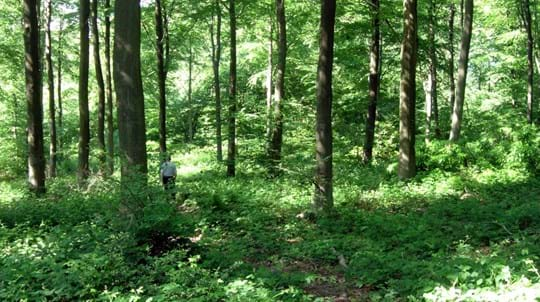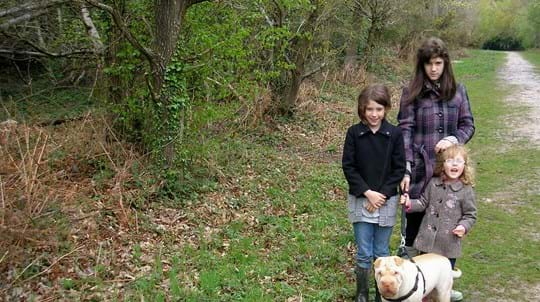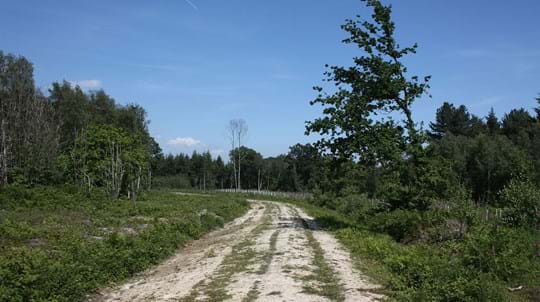
Brede High Woods
Cripps Corner near Battle East Sussex

Woodland Trust wood
261.89 ha (647.13 acres)
TQ793201
Explorer 125
OS Landranger 199
Brede High Woods is home to astonishingly rare wildlife, diverse habitats and long-forgotten iron works. Roam the network of paths and rides through dense ancient woodland, open grassland and sandy heaths in the High Weald Area of Outstanding Natural Beauty.
Catch a glimpse of the strange eel-like lamprey as they swim up woodland streams, spot the medieval tree-lined bank, or look for some of Britain’s rarest beetles.
Features
- Parking at site
- Public access
- Autumn colour
- Spring flowers
- Waymarked walk
How to get to Brede High Woods
Brede High Woods (647 acres) lies on the south-facing slopes of a tributary valley of the River Brede, 9.7km (6 miles) north of Hastings and 8km (5 miles) north-east of Battle. It is located in the High Weald Area of Outstanding Natural Beauty just south of the B2089, between Cripps Corner and Broad Oak Brede.
From Battle, head north towards Sevenoaks on the A2100 for 4.8km (3 miles), then take the second exit at the roundabout onto the A21 Vinehall Road. After 1.5km (1 mile) turn left towards the B2089 and continue along this road for approximately 5.6km (3.5 miles).
The B2089 Broad Oak to Cripps Corner road runs along the northern edge of Brede.
The nearest train station is at Robertsbridge (9.7km/6 miles from Brede). Hastings (16km/10 miles away) train station is the only one that has a direct bus connection.
Visit National Rail for more information.
The closest bus stop is at Cripps Corner, about 400 metres from the nearest entrance into the wood.
Visit Traveline for more information.
Facilities and access
There are 15 minor entrances into the wood from the surrounding roads and lanes. Most have narrow squeeze gaps.
From the two car parks there are routes into the wood via an all-ability kissing gate (RADAR key required) or steps. Three of the tracks into the wood from the B2089 are surfaced from the entrances, but beyond that most rides and paths are unsurfaced and very prone to waterlogging. Some are also very rutted. Several have grassy surfaces but most are bare soil. There are some moderate gradients leading down towards the reservoir to the south.
From the bus stop in Cripps Corner, follow the pavement east on the B2089, looking out for the Woodland Trust logo on a small squeeze-gap entrance on the other side of the road.
There are two free car parks available at Brede High Woods, on the south side of the B2089 Cripps Corner/Broad Oak Brede Road, marked by brown tourist signs.
The nearest public toilets are in Sedlescombe in the public car park off Brede Lane, 6.4km (4 miles) from Brede High Woods. Disabled facilities are available with a RADAR key, but there are no baby changing facilities.
Wildlife and habitats
Brede High Woods is a nature-lovers paradise, with an outstanding reputation for wildlife. Thousands of species rely on the site, from the smallest, rarest of beetles and beautiful butterflies to large mammals, such as deer and badgers.
The mix of ancient and secondary woods, streams, heath and grassland means you can spot wildlife all year round. Carpets of bluebells light up the woods in spring, wild flowers attract butterflies in summer, and vivid autumn leaves – their hues matched on the ground by colourful fungi - last into the winter.
Animals
Brede High Woods is home to an array of threatened, diverse and unusual species. The ponds and streams provide the perfect habitats for water voles and great crested newts, as well as the strange eel-like brook lamprey, while spotted flycatchers can be seen along the woodland edges.
Renowned for its invertebrates, Brede High Woods is the only known UK location of the flea beetle (Longitarsus longiseta), previously thought to be extinct in the UK. The acid grassland also has a population of glow-worm, a Sussex priority species.
Bats are often on the wing at dusk during the summer months and if you’re patient and quiet, and you may see smaller creatures, such as weasels. Foxes and badgers are both common, but badgers rarely come out before dark. You may see roe and fallow deer, and there is increasing evidence of the presence of wild boar.
Trees, plants and fungi
From carpets of bluebells in spring to purple heather and yellow dwarf gorse in summer, clumps of colourful fungi in autumn and delicate hazel catkins in winter, Brede High Woods is a nature-lover’s paradise.
During the spring, early purple orchids, primroses and violets are among the first flowers to appear, closely followed by perfumed carpets of bluebells. If you’re hoping to admire the full beauty of the bluebells, visit during late April and early May. Another lovely spring flower found in Brede High Woods is the wood anemone, whose white star-like flowers shine in great drifts throughout the deepest, darkest tangle of woods during March and April. Rafters Wood to the south of Reservoir Lane is a great place to see them.
In all, 55 species of ancient woodland plants and trees can be found here, including rarer species such as green hellebore and wild service tree.
Habitats
Brede High Woods is one of our biggest woods, covering 647 acres, so there’s a lot to explore. The site lies along the south-facing flank of a tributary of the Brede valley and contains a wide range of habitats typical of the High Weald Area of Outstanding Natural Beauty.
The woodland contains a mixture of trees – oak, sweet chestnut, hornbeam birch, alder, holly, aspen and more. Many areas are ancient woodland, having been continuously wooded since at least 1600.There are also more modern plantations of conifer – Sitka spruce, Scot’s and Corsican pine, Douglas fir and larch.
History of Brede High Woods
Today, Brede High Woods is a quiet and tranquil place in which to relax and enjoy the trees and wildlife. But this peace belies its industrial and agricultural past. Evidence for these activities can be seen throughout the woodland in the form of pits, mounds, banks, ditches and living trees.
The wood has seen hop farming and iron manufacture. You can still spot hop growing in the wood and archaeological excavations uncovered ironworking dating back to the Roman period.
Archaeological work also found a 17th century farmstead with evidence of livestock management and hop processing. The structure was demolished in the 1930s and lies in the north-eastern part of Brede High Woods.

Credit: Mick House / WTML
Conservation
The open habitats in Brede High Woods are nationally important because of the rare species they support. One of these is a species of flea beetle that’s found in Holman Wood Field but survives nowhere else in the UK. However, areas of Brede High Woods have been planted with non-native conifers. This impacted the biodiversity and unique habitats at Brede.
We’re working hard at Brede High Woods to protect wildlife and restore threatened habitats. To restore the wood to its former glory, we are gradually removing the conifer trees and have begun the process around biodiversity hotspots, such as streams.
Things to do in Brede High Woods
Walking
The paths at Brede High Woods are unsurfaced and can be muddy in autumn and winter. Due to its size, the wood has many paths and unofficial desire lines. To help navigate the site, download the Brede High Woods map or take a photo of the orientation panels ahead of your walk. These can be found in both the eastern and western car park.
There is a short waymarked loop from the eastern car park of 1.2km (0.7 miles) which takes 30 minutes to complete. If that isn’t far enough, another option is the slightly longer 2.4km (1.5 mile) walk. You can find the map for these routes at the eastern car park.
For history buffs, travel back in time on the Brede High Woods history trail, where you can find medieval woodbanks, coppiced woodland and the area where the former site of Brede High Farm once stood.

Visiting woods
Walking dogs in our woods
Dogs are welcome for walkies in our woods. Take a look at our tips and guidelines for ensuring we keep our woods safe and special for dogs and wildlife.
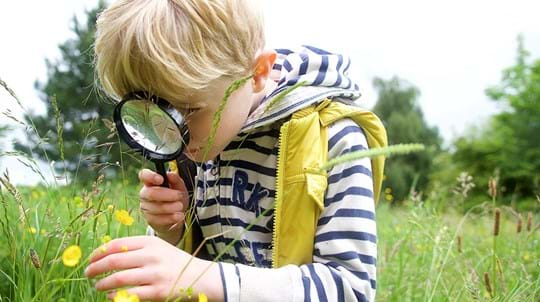
Visiting woods
Events
Discover events at our woods and the festivals and fairs you can find us at soon.
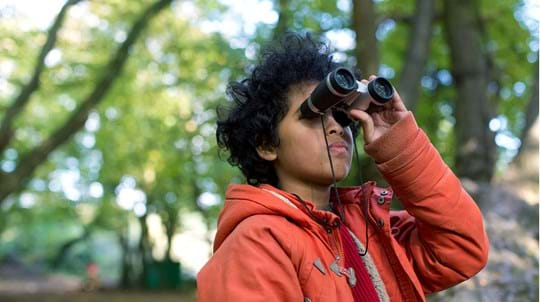
Visiting woods
Things to do in the woods
Go on an adventure. Get closer to nature. Uncover history. Discover ways to explore the UK's woods whatever the season.

A lasting legacy
This wood is just one of many to have been protected by gifts in wills, securing it for generations to come. Your legacy gift could also make a real difference to woods, trees and wildlife.
Learn what your gift could mean




















































